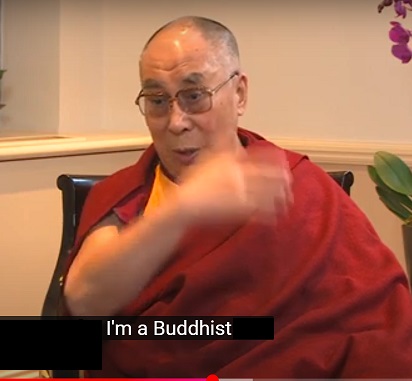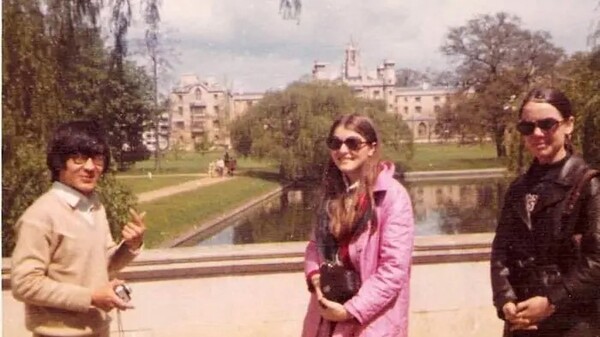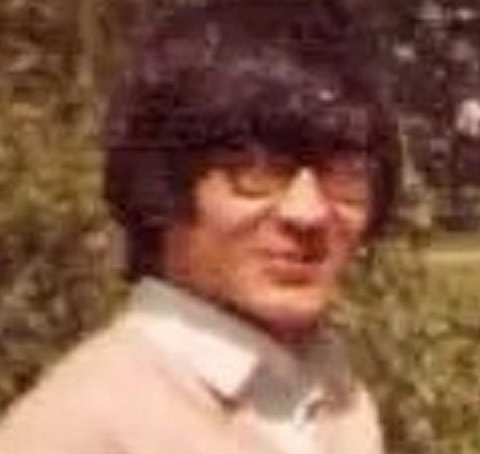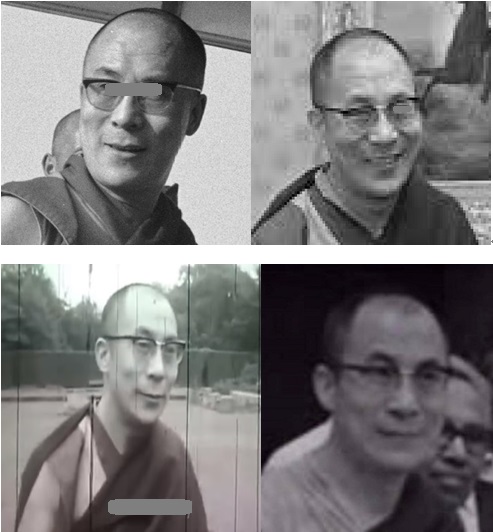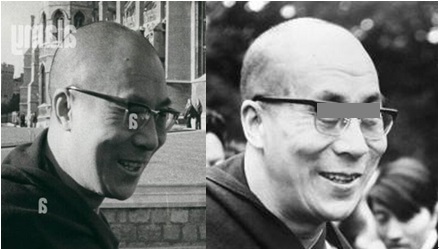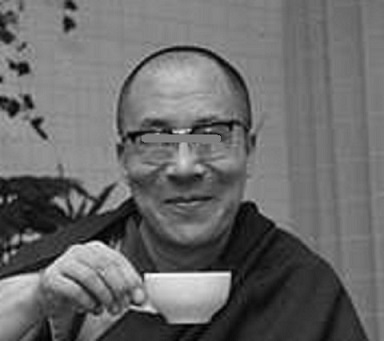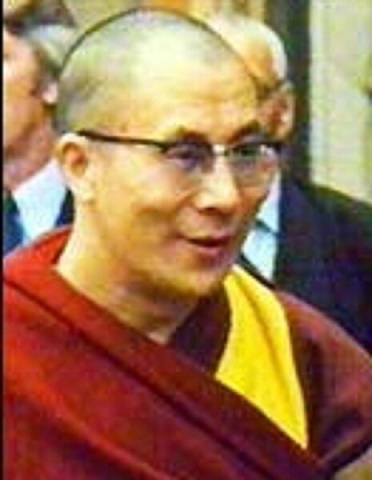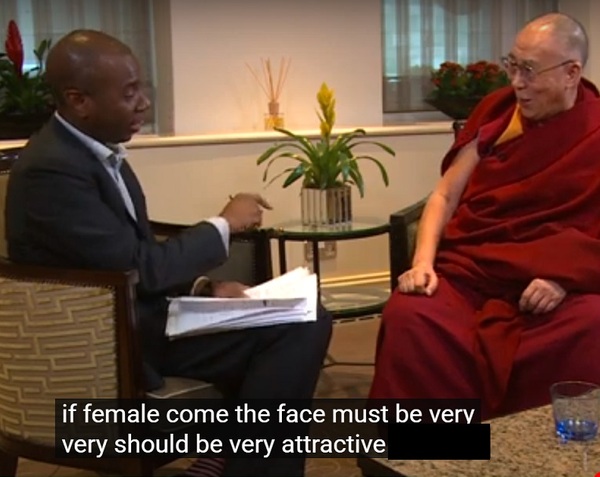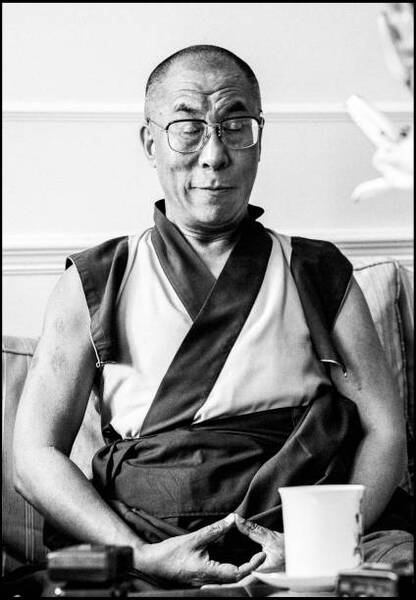| Home » » 雙身法達賴喇嘛秘密大公開 |
破戒——達賴年輕時戴假髮約會白種美女(轉世?) |
達賴喇嘛一直以來以佛教徒的身份呈現在世人面前,而且是出家的佛門僧侶的身份。 然而佛門出家僧侶是禁色的。
文章一經推出,遭到衆多達賴喇嘛官方和非官方的質疑與撇清。 甚至首先公開發表該文的Vice網站,一時之間莫名其妙地無法再打開。
版按: 達賴喇嘛在英國的官方代表只用一句「照片中的人顯然不是達賴喇嘛尊者」的話語倉促無力地去否認。 根據照片中的男女身高差、男性的高鼻梁、非常薄的嘴唇,還有略微向前方翹起的下巴來看,與達賴喇嘛的長相特徵頗爲吻合。 人一定會衰老長皺紋,但是骨相是不會輕易變化的。
圖示:以上照片為達賴喇嘛於1973年訪問歐洲的留影。
可惜年代久遠,照片不夠清晰。本版無法直接證明那就是達賴喇嘛本人,同理,達賴喇嘛官方也同樣無法證明,那不是他本人。
其三,對細節的描述非常契合當時的環境和達賴喇嘛的個性特徵,沒有一處找得到漏洞。
各國政要如果有私下的不太體面的想法,往往都是從大學裏面尋找長相姣好的女大學生。
最後一段細節的描述再貼切不過,沒有宗教信仰的洋人無法編造這樣的細節。對於達賴喇嘛來說,他最引以爲傲的便是他的格魯派教主的身份,他最珍貴的也是他那些所謂過去生的達賴喇嘛傳承下來的器具。在要追求的女性面前,毫無優勢的達賴喇嘛向對方展示那些可以顯示自己尊貴身份、自己最看重的喇嘛器具,是情理中事。此點足以證明約會對象就是達賴喇嘛。這一招在愚昧盲從的西藏女性面前會好用,也許有人主動投懷送抱,但是對沒有信仰密宗喇嘛教的白種、且是受高等教育的女大學生來說,無效! 達賴喇嘛生活在男性父權的環境裏,以一個所謂出家的喇嘛,確實很少與女性尤其西方女性進行交友式的談話。這裏是說他很少與女性進行交友式的談話,而非很少接觸女性,以密宗喇嘛上師雙修的實際操作是直接把藏女、印度女、漢族女明妃剝光了進行大樂光明的。種族和階級觀念深在的達賴喇嘛則對白人女性充滿好奇,或許那白嫩皮膚和豐乳肥臀可以帶給他黃種人沒有的新鮮感和誘惑,然而白人女性普遍强烈的自主意識也讓他一時不知道如何適應和調整策略,快速拉近彼此的關係,只能走悶騷型路綫,看起來有點羞澀,對他來講卻是最安全的。 作者的母親形容達賴喇嘛孩子氣、古怪和令人討厭,很符合一位受過高等教育的西方女性的視角,也很貼切于達賴喇嘛的性格特徵。尊貴,是達賴喇嘛的自我感覺,他放大了自己法王的光環,卻缺少人格魅力,知性女性不會看上他。 其四、達賴喇嘛在2015年接受英國BBC訪問之時,被問到轉世之時的時候,達賴喇嘛說自己來生要轉世為漂亮誘人的金髮女孩。這裏可以看出他潛意識中對於白種金髮女性,是刻在骨頭裏的向往和偏愛。2016年公開場合下對美國女藝人動手動脚的實例也可以作爲佐證。 在2015年9月與BBC記者的訪談中,達賴喇嘛說這個轉世的女孩必須是充滿誘惑力、有魅力的,否則沒什麽用! 「我無意冒犯任何人,這是一句玩笑話。很抱歉有人因為這段不當的言詞而傷害,在此表示誠摯深刻的歉意。」 可是在接受BBC受訪的當時,他怕記者不相信自己的荒唐言論,還强調自己不是開玩笑的。 達賴喇嘛顯露出來對於女性的價值觀,物化女性和以性魅力來篩選女性,恰恰是密宗祖師們一貫的觀點。如陳健民在《曲肱齋全集》中公佈蓮花生的性教導: 《《欲令明点增长,行事业手印(可用明妃而修双身法),当用十六岁(女人)莲(阴户)乳皆肥者,腰细令男(性密宗行者)生不忍(之)乐,自他本尊身明显(观想自己与明妃之本尊明显)。……(即可)与亥母(明妃)密修脉界本尊同时双运,(自夜晚乃至)黎明不断而行,力大根明显,脉界不乱,主要教授即此。》》(34-553丶554) 女性明妃,要挑選那種陰部和乳房都很很豐滿的,可以讓男人生起强烈的、難以控制的性欲。這與達賴喇嘛說自己來生要轉世成爲充滿性誘惑力的金髮美女,否則就沒什麽用,簡直如出一轍。差別僅僅是達賴喇嘛所処的現代文明社會,他只能更隱晦一些。 彼時的達賴喇嘛正處於壯年,有旺盛的性需求。 在接受《紐約時報》採訪時,當被問及自己的弱點時,他回答道:「當然,有時是美女……不過,很多僧侶都有同樣的經歷。一部分原因是出於好奇:如果你用這個,是什麼感覺?[指著自己的陰部]。」 在這裏,達賴喇嘛可以在公開場合用手指著自己的陰部,很不雅觀!實際他講別的僧侶對於性交好奇的時候,也在講他自己。 上世紀九十年代,影視演員Brian Blessed曾經與他共住了三天,是否有不便公開的事情發生無從得知,但是這位男演員有追問達賴喇嘛的性慾,得到的回答是: 「我確實經常想到性愛。但之後我會大聲念誦咒語,然後洗個冷水澡。」 “I do think of sex a lot. But then I do my mantras louder and take a cold shower.” www.dailystar.co.uk/news/latest-news/dalai-lama-often-thinks-sex-31196342 真的僅此而已嗎?强烈旺盛的生理欲望深藏在心底,又在性幻想的催化下,僅僅靠著大聲念咒語和洗冷水澡就能夠止息嗎? 九十年代的達賴喇嘛,年齡接近四十嵗,也正是世俗人性欲很旺盛的時候。 他也坦承了自己經常想到性愛,所以約會夢寐以求的白種女性,他有强烈的動機,本文作者母親披露的約會事件,幾乎可以斷定屬實。 另外一方面,如果真的是久修的修行人轉世來的,從小對於男女欲事幾乎都不會有什麽特別的想法,甚至結交異性和結婚是奉父母之命。 這也反証達賴喇嘛轉世、修行這兩件事情都是子虛烏有。 如果他們真的是佛門修行,他們的轉世顯然是假的,因爲完全沒有修行多生累積的功德受用顯示出來;如果他們的轉世是真的,那麽他們的所謂的修行就是假的,因爲所謂轉世已經轉了十四次了,還陷落在深重的男女欲中無力解脫係縛。 如果大聲念咒語和洗冷水澡可以有效地、徹底地熄滅欲火,他不會常常想到性。 再引申下去,以一個具有强烈性欲的人,擺出自己在打坐的樣子,尚且還需要用冷水澡澆滅欲火,何來定力可言? 不過是在練習坐著睡覺的腿功和睡功。 又如何有神通力,掌握自己來生的去処呢?
更重要的是:作爲一代法王,他一定要如實操練祖師傳下來的法,否則為不肖! 達賴常常拿空性講來講去,那麽他到底有無證悟空性? 密宗喇嘛証悟空性的管道是男女交合。 透過在性愛中運用特殊的專注技巧,經驗豐富的修行者可以延長非常深邃、微妙且強大的狀態,並運用它們來證悟空性。然而,如果你在普通的心理狀態下進行性交,則沒有任何益處。 ——《如何修行》,《通往有意義的人生之路》,達賴喇嘛尊者,傑弗瑞霍普金斯譯 Through special techniques of concentration during sex, competent practitioners can prolong very deep, subtle, and powerful states and put them to use to realize emptiness. However, if you engage in sexual intercourse within an ordinary mental context, there is no benefit." - How to Practice, Way to a Meaningful Life, His Holiness the Dalai Lama, Translated by Jeffrey Hopkins 既然自詡為懂得空性,又身為格魯派應成派中觀的法主,達賴喇嘛到底有無約會似乎已經成爲一個次級問題, 姚秦鳩摩羅什所譯《佛說華手經》不退轉品: 「又不受禁戒,云何名出家?」 (CBETA 2025.R1, T16, no. 657, p. 195c10) 這話套用到吃肉、邪淫的達賴喇嘛的身上,其實是高抬了他。 因爲,達賴喇嘛絕非佛門中人! 附英文原文: My Mom Claims She Went on a Date with the Dalai Lama but he couldnt hit it By Carrie Shirley October 11, 2015, 1:50pm In a BBC interview last month, the Dalai Lama suggested that, if his successor were to be a woman, she would have to be attractive, otherwise “not much use.” With the breathy, halting chuckle of a man whose joke did not land, he doubled down on his assertion. “It’s true!” he stammered, as the interviewer tried to change the subject. Reception to this interview ranged from shock to anger. For decades, the Dalai Lama has been the most universally well-liked religious figure and public figure in general. How could he say something so inflammatory and backwards about women? Has he always been like this, and we just never noticed? While social media affords us an intimate—if often one-sided—relationship with celebrities, figures like the Dalai Lama still prove impregnable despite their attempts at candor. It’s one thing to watch someone live-stream their colonic on Periscope; it’s another to simply spend the day with them. Forty years ago, my mom did just that. According to her, she went on a date with the Dalai Lama. At the time my mom was studying at the Architectural Association in London; the Dalai Lama was visiting Cambridge to meet with Sir Karl Popper, David Bohm, and Carl Friedrich von Weizsäcker of their astrophysics department in an effort to find common ground between science and Buddhism. Tenzin Gyatso was identified as the 14th Dalai Lama at age two, taken to Lhasa to be educated by monks in a 1,000-room palace, and instated as the political leader of Tibet at age 15. When he and my mom met, he had been in exile for 14 years, living in India. My mom was 22. She was living on Regents Park Road with two other women in what was essentially a one-bedroom apartment with a large closet that could hold a twin bed. She and her friend Daisy—who was in London to study opera—slept in the bedroom together. They had many short-term sub-tenants. But that fall, they hosted an art history grad student named Carolyn. And Carolyn set up the date with the Dalai Lama. “He wanted to meet some American women,” my mom recalled. In a 1993 interview with the New York Times, the Dalai Lama said, “Even in the 1960s and 1970s, I didn’t have much knowledge of [women’s issues].” This is putting it mildly, according to my mom. “He seemed very naive…maybe a little shy around girls,” she said. In some ways, the date was fairly ordinary: Carolyn, Daisy, and my mom took the train to Cambridge to go on a walking tour of the campus with their gentleman caller. In other ways, it was less so—he introduced himself to them as the Dalai Lama, sticking to formalities. “I didn’t know how to address him, so I just waved when I wanted his attention,” my mom said. In addition to the walking tour, my mom and her friends were treated to a tour of his room, where he had set up a shrine with “ancient artifacts,” which he told them were “from B.C.” Then he and my mom went out on the River Cam. “He did not do any of the work,” she recalled. “I had to do all the punting.” My mom punted the small boat along the river while the Dalai Lama sat cradled on the cushioned bench, remarking on the Cambridge scenery. “He was a little weird and hard to talk to,” my mom said, so his recent comments didn’t surprise her. And widespread shock seems a little late in the game, at this point. The truth is that the Dalai Lama has made this “joke” about a female Dalai Lama many times: with Larry King, with German Buddhist writer Michaela Doepke, with the Sunday Times—to name a few. In his BBC interview, he makes this joke in reference to some half-forgotten interview he did in Paris with a French women’s magazine 20 or 30 years ago. It’s also perhaps misleading to label this viewpoint a joke, since he makes the same argument earnestly in his autobiography, My Spiritual Journey. “Beauty is one of the eight qualities of a precious human body on the physical level,” he wrote. “It is obvious that if a female Dalai Lama is ugly to look at, she will attract fewer people. The aim of a female reincarnation is to transmit the Buddhist teachings to the public in a convincing way.” For all his demi-divinity, the Dalai Lama is certainly not above a dick joke. And the Dalai Lama makes no secret of the way that attractive human bodies affect him. In a New York Times interview, when asked about his weaknesses, he replied, “Of course, sometimes beautiful women…But then, many monks have the same experience. Some of it is curiosity: If you use this, what is the feeling? [Points to his groin.]” For all his demi-divinity, the Dalai Lama is certainly not above a dick joke. The Dalai Lama is the successor in a line of incarnations of the Buddha of Compassion, Avalokitesvara. The Avalokitesvara is variably depicted as male or female, but in Tibetan Buddhism, he is always male. Professor Rita Gross, author of Buddhism After Patriarchy, notes, “Tibetan Buddhism is very patriarchal.” This strain of Buddhism was established in the 14th century. The title Dalai Lama arose in 1587, and by 1641, the Dalai Lama—this one was the fifth—had complete political and religious authority over Tibet. He was considered to be Tibet’s greatest leader, until Tenzin Gyatso. In the past, Dalai Lamas indicated where they will be reincarnated by writing a letter to be read after their death, or a prominent lama will have dreams of the child’s house, or heavenly signs will surface. In the case of the current Dalai Lama, an omen predicted his identity. Eighteen months after the death of the 13th Dalai Lama, Tibet was in political turmoil. The monks consulted with the Dalai Lama’s embalmed body, which was set up in the lotus posture gazing southward for meditation. When a few observant monks noticed that the figure’s head tilted eastward, even a day after their correction, they were convinced that his successor would be found in the east. In many ways, the reincarnated form the Dalai Lama takes is a reflection of the needs of Tibet and Tibetan Buddhism at the time. The Dalai Lama before Tenzin Gyatso left Tibet in turmoil, and a successor—the right kind of successor—had to be found immediately. As Gross puts it, “All religions reflect their social settings.” And Tibet has a tradition of thinking of women as inferior. The word for “woman” in the Tibetan language literally translates to “born low.” This hierarchical attitude is at odds with what Gross calls “the true Buddhist teachings.” “Buddhists can’t come up with the same excuses for male dominance.” Yet reincarnated leaders almost always take male form. The institution of reincarnation essentially upholds the status quo. However, Gross goes on to say, “There has been some shift among some of the more prominent leaders of the Buddhist world.” In his biography, the Dalai Lama said that the next Dalai Lama could be a woman or a man. The current Dalai Lama has made conflicting comments regarding his successor. In his biography, he asserts, “I have told the Tibetan people that it is up to them to decide whether they want another reincarnation…Reincarnation is about continuing your work from the previous life. If they think my work is important and relevant, I will reincarnate.” But later, in an interview with the German newspaper Welt am Sonntagg, he suggested that he believes that, “the institution of the Dalai Lama has served its purpose. We had a Dalai Lama for almost five centuries. The 14th Dalai Lama now is very popular. Let us then finish with a popular Dalai Lama.” In the meantime, the People’s Republic of China has stated that they will be choosing the next Dalai Lama after Tenzin Gyatso passes away. In his biography, the Dalai Lama said that the next Dalai Lama could be a woman or a man, that “the institution of the Dalai Lama must change according to the times.” “That’s come a long way for popular Tibetan Buddhism,” says Gross. “Whether it’s going to amount to anything, that’s an open question.” In the Tibetan Buddhist tradition, the Buddha of Compassion has a female aspect called Tara. Often called the Mother of all Buddhas, some stories trace her back to an original princess who attained a high level of enlightenment. A group of monks suggested that she should pray to be reborn as a man, so that she could progress further. Tara refused, saying that those who see gender as a barrier to attaining enlightenment are “weak-minded worldlings.” She resolved to always be reborn as a woman. The current Dalai cited Tara as an example of “a true feminist movement in Buddhism.” Women can be symbols for worship, but they cannot be leaders with legitimate political and religious power. In Tibet, Sri Lanka, and Thailand, nuns were prevented from receiving the highest ordinations. At the same time, there are lineages in the Tibetan tradition of female high reincarnations. In short: female practitioners are kept from power; female figures enjoy reverence. Gross notes that Tara is the most popular deity in Tibet—male or female. Again, there’s a difference between the letter of Buddhist teachings, and how they’re carried out. Women can be symbols for worship, but they cannot be leaders with legitimate political and religious power. For his part, the Dalai Lama has stated that he is a feminist. “Isn’t that what you call someone who fights for women’s rights?” he asked during a 2009 speech at the National Civil Rights Museum in Memphis, TN. Gross is optimistic: “I think the Dalai Lama is sincere. The real question is whether the Tibetan people would accept.” After their day with the Dalai Lama, my mom and her friends returned to their tiny apartment. “We didn’t make fun of him. Probably we giggled about him afterward,” she said. And then the calls started. He called them more than three times, asking to “get together again.” “It was kind of like having someone’s little brother call you for a date,” my mom said. When I asked her why she didn’t take him up on his offer, my mom replied, “It didn’t seem appropriate. Because of who he is and was. And because he did seem so boyish. It was peculiar.” For someone with inherited centuries of wisdom and decades of Buddhist study, the Dalai Lama lacked one thing: He couldn’t speak to women. Couldn’t make conversation with them, couldn’t relate to them, and certainly couldn’t hit on them. As my mom said, “He was just a pest.” Forty years later, not much has changed. Upon reviewing this article, Wangdue Tsering, Secretary of The Office of Tibet, London—the official representative of His Holiness the Dalai Lama in the UK—said, “There was no date with His Holiness the Dalai Lama. Moreover, it is clear the man in the photo is not His Holiness the Dalai Lama.” https://www.vice.com/en/article/my-mom-went-on-a-date-with-the-dalai-lama-in-all-his-awkward-glory/
|
| Home » » 雙身法達賴喇嘛秘密大公開 |

简体 | 正體 | EN | GE | FR | SP | BG | RUS | JP | VN 西藏密宗真相 首頁 | 訪客留言 | 用戶登錄 | 用户登出
- 評論南傳佛教上座部及印順法師
- 喇嘛教本質的海濤法師放生爭議
- 雙身法黃教祖師--宗喀巴(廣論)淫人妻女秘密大公開
- 淨空法師揭發邪惡之偽藏傳佛教開示輯
- 慧律法師破斥藏傳假佛教及「人間佛教」之邪說
- 淫人妻女之活佛喇嘛(偽藏傳佛教)性侵害事件秘密大公開
- 雙身法六字大明咒秘密大公開
- 十七世大寶法王噶瑪巴性醜聞
- 高僧學者名人批判雙身法之西藏密宗(偽藏傳佛教)證據大公開
- 藏密本質的聖輪法師性醜聞事件簿
- 雙身法達賴喇嘛秘密大公開
- 殘暴的偽藏傳佛教、西藏密宗、喇嘛教殺人證據
- 宗教性侵防治文宣教育(歡迎流通)
- 雙身法喇嘛教(西藏密宗、偽藏傳佛教)秘密大公開
- 雙身法紅教祖師--蓮花生(大圓滿)淫人妻女秘密大公開
- 雙身法白教祖師--密勒日巴(大手印)淫人妻女秘密大公開
- 真心新聞網、各家宗教新聞
- 漫畫-密宗活佛、喇嘛、仁波切
- 喇嘛教雙身法連載專欄:台灣玉教室
- 偽藏傳佛教雙身法分享專欄:-讀者來鴻
- 罪惡達賴 罪惡時輪
- 偽藏傳佛教(藏密)問答錄●學密基本常識
- Swami瑜伽性侵大師
- 人面獸心-索達吉堪布雙修大揭密
- 國學大師-南懷瑾雙修大揭密
- 卡盧仁波切雙修大揭密
- 索甲仁波切雙修大揭密
- 真佛宗盧勝彥雙修大揭密
- 破斥藏密多識喇嘛《破魔金剛箭雨論》之邪說
- 陳健民上師講述如何修學密宗邪淫男女雙修灌頂
- 剖析天鑒網悲智版主愚癡言論輯
- 嗜血啖肉的人間羅剎---喇嘛教絕非佛教
- 嗜食糞尿精血等穢物的藏傳佛教
- 附佛外道-法輪功的秘密
- 揭發「藏傳佛教」轉世活佛的騙人內幕
- 認識真正善知識-蕭平實老師
- 偽藏傳佛教詩詞賞析
- 第一部揭開西藏神秘面紗的大戲--西藏秘密
- 破斥遼寧海城大悲寺妙祥法師抵制正法
- 破斥一貫道
- 破斥瑯琊閣
佛教未傳入西藏之前,西藏當地已有民間信仰的“苯教”流傳,作法事供養鬼神、祈求降福之類,是西藏本有的民間信仰。
到了唐代藏王松贊干布引進所謂的“佛教”,也就是天竺密教時期的坦特羅佛教──左道密宗──成為西藏正式的國教;為了適應民情,把原有的“苯教”民間鬼神信仰融入藏傳“佛教”中,從此變質的藏傳“佛教”益發邪謬而不單只有左道密宗的雙身法,也就是男女雙修。由後來的阿底峽傳入西藏的“佛教”,雖未公然弘傳雙身法,但也一樣有暗中弘傳。
但是前弘期的蓮花生已正式把印度教性力派的“双身修法”帶進西藏,融入密教中公然弘傳,因此所謂的“藏傳佛教”已完全脱離佛教的法義,甚至最基本的佛教表相也都背離了,所以“藏傳佛教”正確的名稱應該是“喇嘛教”也就是──左道密宗融合了西藏民間信仰──已經不算是佛教了。

